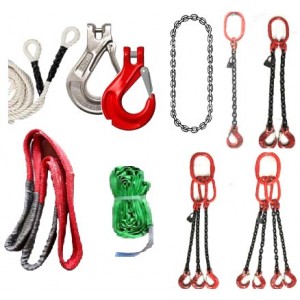Lifting slings are one of the many types of lifting equipment products that we offer here at Lifting Gear Direct. As you can see from our site, we have 13 different categories of lifting equipment alone, so you’d be forgiven for sometimes wondering which may be the best for your operation!
For that reason, here we have put together a handy little guide, focusing on eight of the most frequently asked questions that we receive about lifting slings.
#1 What are lifting slings?
Perhaps the most obvious question, and one which the more knowledgeable of you in the industry already know the answer too, but an important question nonetheless. The term is a broad one, applying to a large category of equipment. But, essentially, these are tools that consist of wire cable, chain, fibre rope or webbing which is used to attach the load to a hoist or crane in order to facilitate lifting the load”
#2 What are the benefits of using a lifting sling?
When a heavy load needs to be lifted by a hoist and crane system or similar, how do you attach the load? Some form of lifting sling will be the answer. Softer lifting slings like fibre ropes, round slings, one way slings and web slings are great for when loads need more protection. Chain slings and wire rope slings tend to be for more industrial use. Each type can be made to suit your needs. For example you may need a 6 metre webbing sling to lift 3 tonnes or perhaps a 4 leg chain sling to handle 5 tonnes. Lifting Gear direct can help with all your lifting requirements.
#3 What are the different types of sling?
The main types of lifting sling that we manufacture and stock are:
- Round
- Web
- Disposable one way
- Fibre rope
- chain
- Wire rope
For more information on each specific type of equipment, please refer to our product page here.
#4 What laws apply to this gear?
Although lifting slings are different to other types of lifting equipment, the same rules and regulations still apply to them. The most important of these are the Lifting Operations and Lifting Equipment Regulations 1998 (LOLER).
To summarise, LOLER requires that any operation involving lifting slings have been properly planned, and are supervised and operated by knowledgeable and competent workers.
#5 Should I use webbing slings or round slings?
A common question that we get asked is whether one should use a webbing sling or a round sling. While this will change depending on your operation, generally speaking round slings are endless and also softer, so therefore more protective to the load thanks to the tubular design filled with high tensile woven materials for softness and strength, while webbing slings are totally flat with a formed lifting eye at each end. The larger the SWL the wider the web strap will be, round slings will have a larger tube diameter. Both types are available in similar lengths and safe working loads.
#6 What is the colour coding system for slings?
Some slings, particularly webbing slings, have a universal UK colour coding system to quickly show what weight they are capable of lifting. This is:
- Purple – one tonne
- Green – two tonnes
- Yellow – three tonnes
- Grey – four tonnes
- Red – five tonnes
- Brown – six tonnes
- Blue – eight tonnes
- Orange – ten tonnes & over
It’s important to note that not all lifting slings will have this colour coding. Instead, it’s crucial that you refer to, and abide by, your manufacturer’s guidelines, which will be supplied with any equipment that you purchase.
#7 Why is polyester used for some slings?
Polyester is one of the most common materials used for many types of sling. The reason for this is that it is lightweight, flexible, highly durable, and suited to operate in many types of high grade, hazardous environments. It also offers a low cost and high resistance alternative to many other materials on the market.
#8 What are some applications for this lifting gear?
There are many applications for this type of gear. Just some of these are listed below:
- Lifting and lowering tasks
- Towing and pulling tasks
- Creating hammocks
- Creating slack-lines
- As rescue gear and safety harnesses
Do you have more questions?
We hope that the above information has been useful in helping to answer any questions that you may have about lifting slings, what they are, and when they should be used. However, if you can’t find an answer to your question, then we’d be more than happy to help! Please just reach out to us here.
Posted On: January 24, 2018
